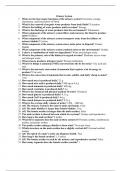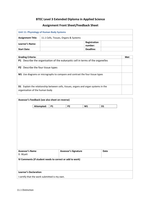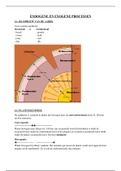Table of content
Chapter 1 Ten Principles of economics....................................................4
Economic Problems:............................................................................................................... 4
Resources:.............................................................................................................................. 4
10 Principles of Marketing...................................................................................................... 4
Chapter 3 the market forces of supply and demand.................................5
1. Market and competition...................................................................................................... 5
1.1 Competition: Perfect and otherwise.............................................................................. 5
2. Demand.............................................................................................................................. 5
2.1 Demand curve.............................................................................................................. 5
2.2 Market demand versus individual demand...................................................................5
2.3 Shifts versus movements along the demand curve......................................................5
3. Supply................................................................................................................................ 7
3.1 Movement along the supply curve................................................................................8
3.2 Shift of the supply curve............................................................................................... 8
4 Supply and demand together.............................................................................................. 8
4.1 Equilibrium.................................................................................................................... 8
4.2 Price as signals............................................................................................................. 8
4.3 Three Steps to analysing changes in equilibrium.........................................................8
Chapter 20 Measuring a nation's income...............................................10
1. The economy’s income and expenditure..........................................................................10
2. Measurement of gross domestic product..........................................................................10
2.1 GDP is the market value............................................................................................. 10
2.2. ... Of all...................................................................................................................... 10
2.3 ...goods and services.................................................................................................. 10
2.4 ... produced................................................................................................................ 10
2.5 ... within a country...................................................................................................... 10
2.6 ...in a given period of time.......................................................................................... 10
3. Components of GDP......................................................................................................... 11
3.1 Consumption.............................................................................................................. 11
3.2 Investment.................................................................................................................. 11
3.3 Government purchases............................................................................................... 11
3.4 Net Exports................................................................................................................. 11
4. Real versus nominal GDP.................................................................................................. 11
4.1 Numerical example..................................................................................................... 11
4.2 GDP deflator............................................................................................................... 11
5. GDP and economic well-being.......................................................................................... 11
Chapter 21 Measuring the cost of living................................................12
1. Consumer Price Index (CPI).............................................................................................. 12
1.1 Calculation of CPI........................................................................................................ 12
1.1 Problems in measuring the cost of living....................................................................12
1.2 CPI, harmonized index of consumer prices and the retail prices index (RPI)..............12
1.3 GDP deflator vs. CPI.................................................................................................... 12
2. Correcting economic variables for the effects of inflation................................................12
2.1 Money figures from different times............................................................................ 12
2.2 Indexation................................................................................................................... 12
2.3 Real and nominal interest rates..................................................................................12
Chapter 22 Production and Growth.......................................................13
1. Growth theory.................................................................................................................. 13
2. Productivity: its role and determination............................................................................13
2.1 Why productivity is so important................................................................................13
2.2 Determinants of economic growth..............................................................................13
2.3 How productivity is determined..................................................................................13
1
, 2.4 Importance of savings and investments.....................................................................14
2.5 Demising returns and the catch-up effect..................................................................14
2.6 Investment from abroad............................................................................................. 14
2.7 Education.................................................................................................................... 14
2.8 Health and Nutrition (Ernährung)............................................................................... 15
2.9 Property rights, political stability and good governance.............................................15
2.10 Free Trade................................................................................................................. 15
2.11 Research and development...................................................................................... 15
2.12 Population Growth.................................................................................................... 15
Chapter 24 Saving, investment and the financial system........................16
1. Financial institutions in the economy............................................................................... 16
1.2 Financial intermediaries............................................................................................. 16
1.3 Other Financial Institutions......................................................................................... 16
1.4 Credit default swaps (CDS) (Verzug)...........................................................................16
1.5 Collateralized debt obligations (CDOs).......................................................................17
2. Savings and investment in the national income accounts................................................17
2.2 Meaning for savings and investments........................................................................17
3. Market for loanable funds................................................................................................. 17
3.1 Supply and demand for loanable funds......................................................................17
3.2 Policy 1: Saving Incentives (Fördergelder)..................................................................18
3.3. Policy 2: Investment Incentives................................................................................. 19
3.4 Government budget deficits and surpluses................................................................19
Chapter 26 the monetary system..........................................................21
1. The meaning of money..................................................................................................... 21
1.1 Functions of money.................................................................................................... 21
1.2 Liquidity...................................................................................................................... 21
1.3 Kinds of money........................................................................................................... 21
1.4 Money in the economy............................................................................................... 21
2. Role of the Central bank................................................................................................... 22
3. European Central bank and the eurosystem....................................................................22
4. Bank of England............................................................................................................ 22
5. Banks and the money supply........................................................................................... 22
5.1 Money fraction with fractional-reserve banking..........................................................22
5.3 Money multiplier......................................................................................................... 23
5.4 Central Bank's tools of monetary control....................................................................23
5.5. Quantitative Easing................................................................................................... 24
5.6 Problems in controlling the money supply..................................................................24
5.7 Changes in banking and the financial crisis................................................................24
Chapter 27 Money growth and inflation.................................................26
1. Classical theory of inflation.............................................................................................. 26
1.1 Money supply, money demand and monetary equilibrium.........................................26
1.2 Effect of a monetary injection..................................................................................... 26
1.3 A brief look at the adjustment process.......................................................................27
1.4 Classical dichotomy and monetary neutrality.............................................................27
1.5 Velocity (Geschwindigkeit) and the quantity equation................................................27
1.6 Inflation tax................................................................................................................ 28
1.7 Fisher effect................................................................................................................ 28
2. Cost of inflation................................................................................................................ 29
2.1 Fall of purchasing power............................................................................................. 29
2.2 Shoe leather costs...................................................................................................... 29
2.3 Menu costs.................................................................................................................. 29
2.4 Relative-Price variability and the misallocation of resources......................................29
2.5 Inflation induced tax distortions (Verzerrung)............................................................29
2.6 Confusion an inconvenience....................................................................................... 30
2.7 Special costs of unexpected inflation: Arbitrary (beliebig) redistributions of wealth. .30
3. Deflation........................................................................................................................... 30
2
,Chapter 28 Open-economy macroeconomics: Basic concepts..................31
1. International flows of goods and capital...........................................................................31
1.1 Flow of goods and services: exports, imports and net exports...................................31
1.2 Flow of financial resources: new capital outflow.........................................................31
1.3 The Equality of Net Exports and Net Capital Outflow..................................................31
1.4 Saving, Investment, and Their Relationship to the International Flows......................32
2. The prices for international transactions: real and nominal exchange rates....................32
2.1 Nominal exchange rate............................................................................................... 32
2.2 Real exchange rates................................................................................................... 32
3. First theory of exchange rates determination: purchasing power parity..........................33
3.1 Basic logic of purchasing power parity.......................................................................33
3.2 Implications of purchasing power parity.....................................................................33
3.3 Limitations of purchasing power parity.......................................................................33
3
, Chapter 1 Ten Principles of economics
Economic Problems:
1. What goods and services should be produced?
2. How should it be produced?
3. Who should get the goods and services produced?
Resources:
1. Land
2. Labour
3. Capital
Scarcity means limited resources and therefore cannot produce all the goods and services
people wish to have.
Economics is the study of how society manages its scarce resources.
Economy refers to all the production and exchange activities that take place every day
Economic activity is how much buying and selling goes on in the economy.
10 Principles of Marketing
1) People face trade-offs - Making decisions Equity - property of distributing economic
prosperity fairly among the members of society
2) Cost of something is "What you give up to get it"- opportunity cost (what I give up
to get that item)
3) Rational people think at the margin - deciding if the marginal benefit higher is than
marginal cost. Marginal changes, incremental adjustment to a action plan
4) People respond to incentives - changing behavior when cost and benefits change,
5) Trade can make everyone better off - each economy can be specialized in the
activities it does best and enjoy better variety
6) Market are usually a good way to organize economic activity
- Market economy, allocating resources, through the decentralized decisions of many firms
and households as the interact in market for goods and services
7) Governments can sometimes improve market outcomes - to promote efficiency and
promote equity.
a) Market failure - a situation in which the market fails to produce an efficient allocation
of resources
b) Externality - uncompensated impact of one persons actions on the well-being of
bystander (pollution)
c) Market power - ability of a single person to unduly influence market prices.
Business cycle - fluctuations in economic activity such as employment and production
Microeconomics - how households and firms make decisions and how they interact in
markets
Macro economics - study of economy wide phenomena, including inflation,
unemployment and economic growth
8) An economy's standard of living depends on its ability to produce goods and
services - GDP per head, value of goods and services produced within a country in a
given period of time divided by the population of a country to give a per capita figure
a) Standard of living - amount of goods that can be purchased by population of country,
inflation-adjusted income per head
4
Chapter 1 Ten Principles of economics....................................................4
Economic Problems:............................................................................................................... 4
Resources:.............................................................................................................................. 4
10 Principles of Marketing...................................................................................................... 4
Chapter 3 the market forces of supply and demand.................................5
1. Market and competition...................................................................................................... 5
1.1 Competition: Perfect and otherwise.............................................................................. 5
2. Demand.............................................................................................................................. 5
2.1 Demand curve.............................................................................................................. 5
2.2 Market demand versus individual demand...................................................................5
2.3 Shifts versus movements along the demand curve......................................................5
3. Supply................................................................................................................................ 7
3.1 Movement along the supply curve................................................................................8
3.2 Shift of the supply curve............................................................................................... 8
4 Supply and demand together.............................................................................................. 8
4.1 Equilibrium.................................................................................................................... 8
4.2 Price as signals............................................................................................................. 8
4.3 Three Steps to analysing changes in equilibrium.........................................................8
Chapter 20 Measuring a nation's income...............................................10
1. The economy’s income and expenditure..........................................................................10
2. Measurement of gross domestic product..........................................................................10
2.1 GDP is the market value............................................................................................. 10
2.2. ... Of all...................................................................................................................... 10
2.3 ...goods and services.................................................................................................. 10
2.4 ... produced................................................................................................................ 10
2.5 ... within a country...................................................................................................... 10
2.6 ...in a given period of time.......................................................................................... 10
3. Components of GDP......................................................................................................... 11
3.1 Consumption.............................................................................................................. 11
3.2 Investment.................................................................................................................. 11
3.3 Government purchases............................................................................................... 11
3.4 Net Exports................................................................................................................. 11
4. Real versus nominal GDP.................................................................................................. 11
4.1 Numerical example..................................................................................................... 11
4.2 GDP deflator............................................................................................................... 11
5. GDP and economic well-being.......................................................................................... 11
Chapter 21 Measuring the cost of living................................................12
1. Consumer Price Index (CPI).............................................................................................. 12
1.1 Calculation of CPI........................................................................................................ 12
1.1 Problems in measuring the cost of living....................................................................12
1.2 CPI, harmonized index of consumer prices and the retail prices index (RPI)..............12
1.3 GDP deflator vs. CPI.................................................................................................... 12
2. Correcting economic variables for the effects of inflation................................................12
2.1 Money figures from different times............................................................................ 12
2.2 Indexation................................................................................................................... 12
2.3 Real and nominal interest rates..................................................................................12
Chapter 22 Production and Growth.......................................................13
1. Growth theory.................................................................................................................. 13
2. Productivity: its role and determination............................................................................13
2.1 Why productivity is so important................................................................................13
2.2 Determinants of economic growth..............................................................................13
2.3 How productivity is determined..................................................................................13
1
, 2.4 Importance of savings and investments.....................................................................14
2.5 Demising returns and the catch-up effect..................................................................14
2.6 Investment from abroad............................................................................................. 14
2.7 Education.................................................................................................................... 14
2.8 Health and Nutrition (Ernährung)............................................................................... 15
2.9 Property rights, political stability and good governance.............................................15
2.10 Free Trade................................................................................................................. 15
2.11 Research and development...................................................................................... 15
2.12 Population Growth.................................................................................................... 15
Chapter 24 Saving, investment and the financial system........................16
1. Financial institutions in the economy............................................................................... 16
1.2 Financial intermediaries............................................................................................. 16
1.3 Other Financial Institutions......................................................................................... 16
1.4 Credit default swaps (CDS) (Verzug)...........................................................................16
1.5 Collateralized debt obligations (CDOs).......................................................................17
2. Savings and investment in the national income accounts................................................17
2.2 Meaning for savings and investments........................................................................17
3. Market for loanable funds................................................................................................. 17
3.1 Supply and demand for loanable funds......................................................................17
3.2 Policy 1: Saving Incentives (Fördergelder)..................................................................18
3.3. Policy 2: Investment Incentives................................................................................. 19
3.4 Government budget deficits and surpluses................................................................19
Chapter 26 the monetary system..........................................................21
1. The meaning of money..................................................................................................... 21
1.1 Functions of money.................................................................................................... 21
1.2 Liquidity...................................................................................................................... 21
1.3 Kinds of money........................................................................................................... 21
1.4 Money in the economy............................................................................................... 21
2. Role of the Central bank................................................................................................... 22
3. European Central bank and the eurosystem....................................................................22
4. Bank of England............................................................................................................ 22
5. Banks and the money supply........................................................................................... 22
5.1 Money fraction with fractional-reserve banking..........................................................22
5.3 Money multiplier......................................................................................................... 23
5.4 Central Bank's tools of monetary control....................................................................23
5.5. Quantitative Easing................................................................................................... 24
5.6 Problems in controlling the money supply..................................................................24
5.7 Changes in banking and the financial crisis................................................................24
Chapter 27 Money growth and inflation.................................................26
1. Classical theory of inflation.............................................................................................. 26
1.1 Money supply, money demand and monetary equilibrium.........................................26
1.2 Effect of a monetary injection..................................................................................... 26
1.3 A brief look at the adjustment process.......................................................................27
1.4 Classical dichotomy and monetary neutrality.............................................................27
1.5 Velocity (Geschwindigkeit) and the quantity equation................................................27
1.6 Inflation tax................................................................................................................ 28
1.7 Fisher effect................................................................................................................ 28
2. Cost of inflation................................................................................................................ 29
2.1 Fall of purchasing power............................................................................................. 29
2.2 Shoe leather costs...................................................................................................... 29
2.3 Menu costs.................................................................................................................. 29
2.4 Relative-Price variability and the misallocation of resources......................................29
2.5 Inflation induced tax distortions (Verzerrung)............................................................29
2.6 Confusion an inconvenience....................................................................................... 30
2.7 Special costs of unexpected inflation: Arbitrary (beliebig) redistributions of wealth. .30
3. Deflation........................................................................................................................... 30
2
,Chapter 28 Open-economy macroeconomics: Basic concepts..................31
1. International flows of goods and capital...........................................................................31
1.1 Flow of goods and services: exports, imports and net exports...................................31
1.2 Flow of financial resources: new capital outflow.........................................................31
1.3 The Equality of Net Exports and Net Capital Outflow..................................................31
1.4 Saving, Investment, and Their Relationship to the International Flows......................32
2. The prices for international transactions: real and nominal exchange rates....................32
2.1 Nominal exchange rate............................................................................................... 32
2.2 Real exchange rates................................................................................................... 32
3. First theory of exchange rates determination: purchasing power parity..........................33
3.1 Basic logic of purchasing power parity.......................................................................33
3.2 Implications of purchasing power parity.....................................................................33
3.3 Limitations of purchasing power parity.......................................................................33
3
, Chapter 1 Ten Principles of economics
Economic Problems:
1. What goods and services should be produced?
2. How should it be produced?
3. Who should get the goods and services produced?
Resources:
1. Land
2. Labour
3. Capital
Scarcity means limited resources and therefore cannot produce all the goods and services
people wish to have.
Economics is the study of how society manages its scarce resources.
Economy refers to all the production and exchange activities that take place every day
Economic activity is how much buying and selling goes on in the economy.
10 Principles of Marketing
1) People face trade-offs - Making decisions Equity - property of distributing economic
prosperity fairly among the members of society
2) Cost of something is "What you give up to get it"- opportunity cost (what I give up
to get that item)
3) Rational people think at the margin - deciding if the marginal benefit higher is than
marginal cost. Marginal changes, incremental adjustment to a action plan
4) People respond to incentives - changing behavior when cost and benefits change,
5) Trade can make everyone better off - each economy can be specialized in the
activities it does best and enjoy better variety
6) Market are usually a good way to organize economic activity
- Market economy, allocating resources, through the decentralized decisions of many firms
and households as the interact in market for goods and services
7) Governments can sometimes improve market outcomes - to promote efficiency and
promote equity.
a) Market failure - a situation in which the market fails to produce an efficient allocation
of resources
b) Externality - uncompensated impact of one persons actions on the well-being of
bystander (pollution)
c) Market power - ability of a single person to unduly influence market prices.
Business cycle - fluctuations in economic activity such as employment and production
Microeconomics - how households and firms make decisions and how they interact in
markets
Macro economics - study of economy wide phenomena, including inflation,
unemployment and economic growth
8) An economy's standard of living depends on its ability to produce goods and
services - GDP per head, value of goods and services produced within a country in a
given period of time divided by the population of a country to give a per capita figure
a) Standard of living - amount of goods that can be purchased by population of country,
inflation-adjusted income per head
4





